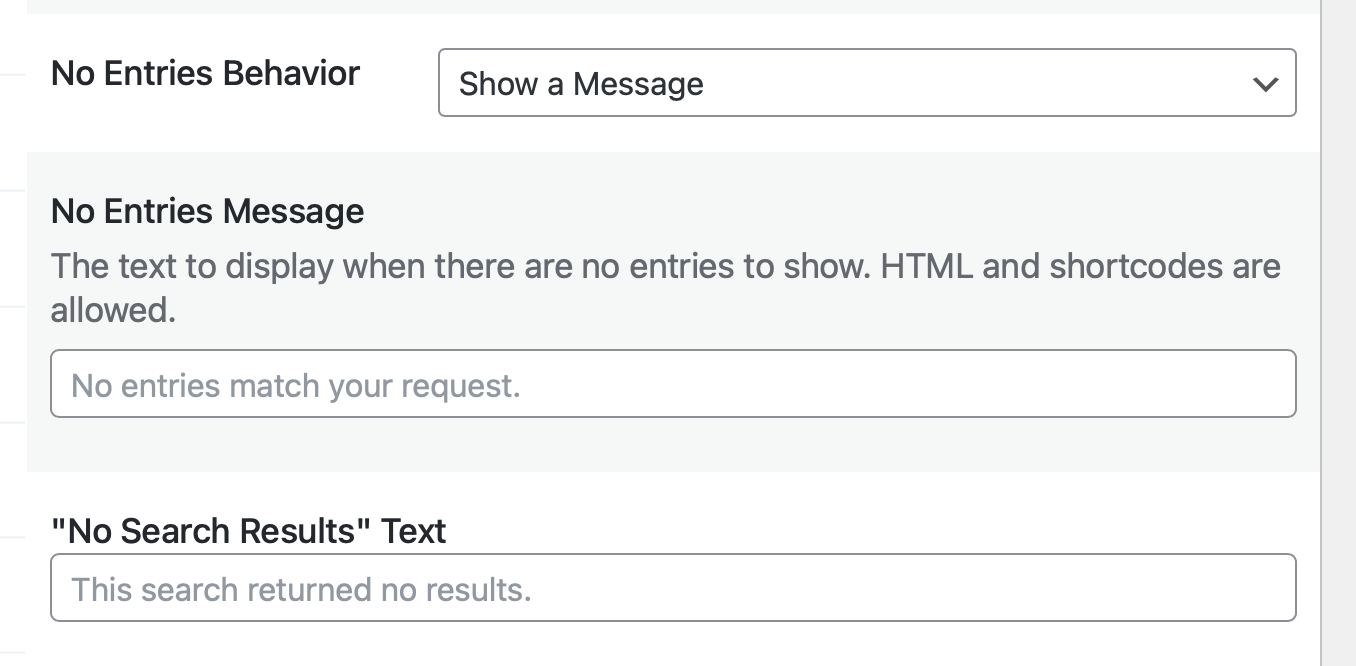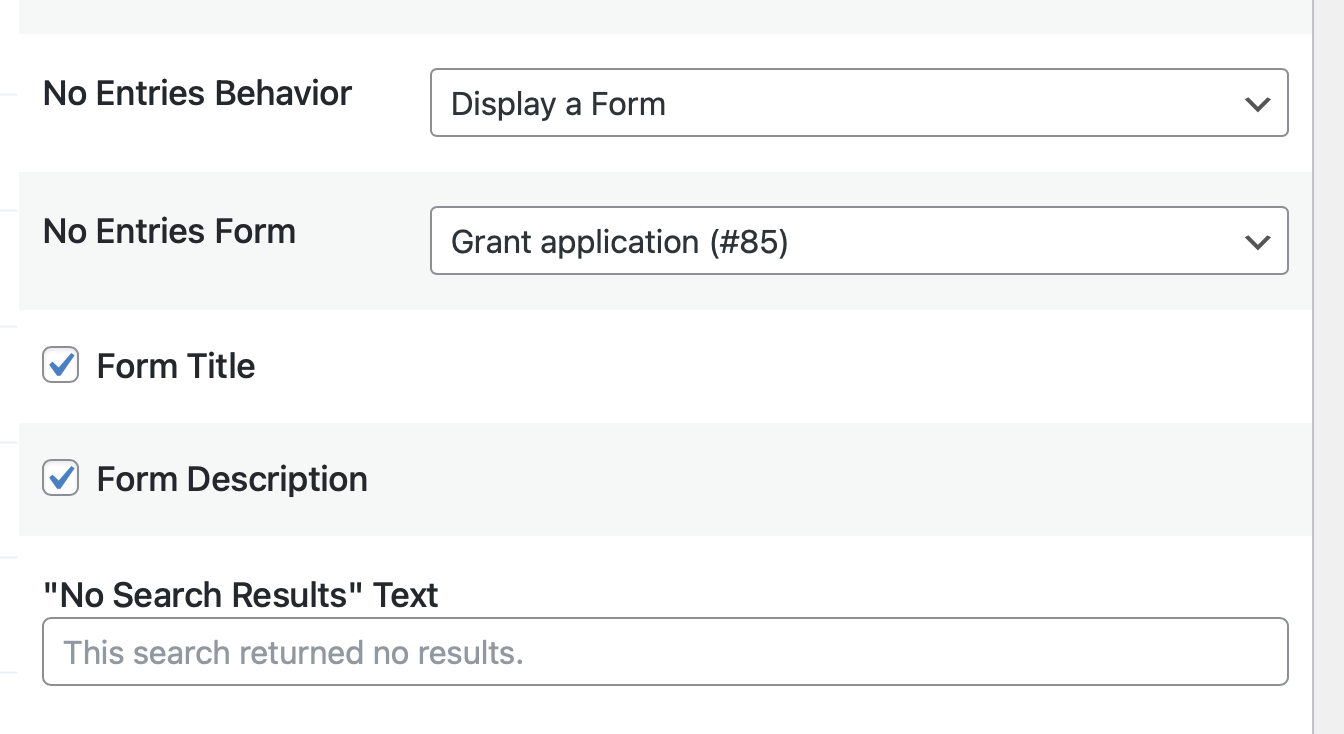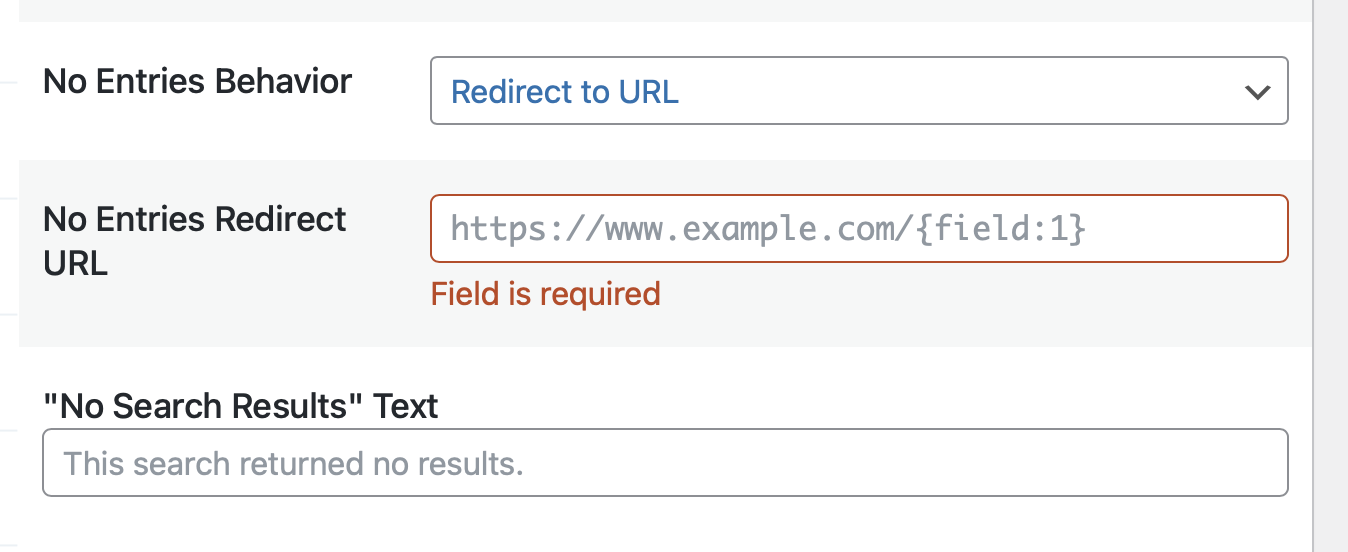Understanding the "No Entries Behavior" setting in GravityView
Control exactly what happens when your View has no entries to display with four distinct behavior options.
Overview
The No Entries Behavior setting determines what visitors see when a View contains no entries. This occurs when:
- The connected form has no entries at all
- View filters (configured in the View editor) exclude all existing entries
- All entries are unapproved (when approval is required)
- User-specific View filters exclude all entries
- Date-based View filters exclude all entries
Note: This is different from the "No Search Results" message, which appears when a visitor performs a front-end search that returns no results. The No Entries Behavior applies when the View itself has no entries to display, regardless of search.
Behavior options
GravityView offers four different behaviors when no entries are available:
Option 1: Show a Message (Default)

What happens: Displays a customizable text message where the View would normally appear.
Default message: "No entries match your request."
Configuration options:
- No Entries Message: Customize the message text
- Supports HTML and shortcodes (except in DataTables layout)
- Can include links, formatting, or dynamic content (except in DataTables layout)
Note: In the DataTables layout, HTML is sanitized and displays as plain text. Use simple text messages without HTML formatting when using DataTables.
Best for:
- Providing helpful context about why no entries appear
- Including instructions for visitors
- Linking to submission forms or other pages
- Explaining filter or search requirements
Example messages:
- "No events scheduled for this month. Check back soon!"
- "No entries have been submitted yet. Be the first to submit an entry." (DataTables-safe)
- "You haven't submitted any entries yet. Create your first entry here." (HTML for other layouts)
- "No data available." (Simple text for DataTables)
Option 2: Display a Form

What happens: Shows a Gravity Forms form in place of the empty View.
Configuration options:
- No Entries Form: Select which form to display
- Form Title: Show or hide the form title
- Form Description: Show or hide the form description
Best for:
- New directories needing initial content
- Encouraging submissions when the form is empty
- Views with restrictive filters that exclude current entries
- User dashboards for first-time visitors
How it works:
- Instead of empty results, the selected form appears
- Visitors can submit entries directly
- After submission, if the entry matches View criteria, it displays immediately
- The form remains available for additional submissions
Use cases:
- Business directory: "Be the first to list your business!"
- Job board: "No jobs in this category. Post one now!"
- Event calendar: "No upcoming events. Submit yours!"
Option 3: Redirect to URL

What happens: Automatically redirects visitors to a specified URL when no entries exist.
Configuration options:
- No Entries Redirect URL: The destination URL
- Supports merge tags for dynamic redirects
- Can include URL parameters
Best for:
- Sending users to dedicated submission pages
- Redirecting to related content
- Creating custom "no entries" landing pages
- Handling filtered Views that currently show nothing
Dynamic redirect examples:
https://site.com/submit-form/https://site.com/search/?query={search_query}https://site.com/category/{field:category}/submit/
Use cases:
- Redirect from empty forms to submission pages
- Send logged-out users to registration when no entries exist
- Direct to category-specific submission forms
- Route to help documentation when View filters exclude everything
Option 4: Hide the View

What happens: The entire View is completely hidden using CSS when no entries exist. There is no message, form, or indication that a View exists.
When hiding the View, the empty View is still rendered in HTML, but hidden using CSS.
Configuration options: None.
Best for:
- Clean page layouts when content isn't available
- Conditional content display
- Member-only sections that hide when empty
- Avoiding confusion when filters exclude everything
What visitors see:
- Nothing; the View is hidden with CSS
- Page continues as if View wasn't embedded
- Other page content remains visible
- No indication that a View exists on the page
Use cases:
- User dashboards that only show when data exists
- Filtered Views that disappear when no matches
- Seasonal content that hides when not relevant
- Progressive disclosure interfaces
Choosing the right behavior
Decision matrix
| Scenario | Recommended Option | Why |
|---|---|---|
| Brand new form (no entries) | Display a Form | Encourages initial content creation |
| View filters exclude all entries | Show a Message | Explains the filtering situation |
| User-specific empty View | Display a Form | Prompts users to create their first entry |
| Date filter shows no current entries | Redirect to URL | Takes users to relevant submission page |
| Optional content section | Hide the View | Maintains clean layout when not needed |
| Temporary maintenance | Show a Message | Informs visitors about the situation |
Implementation examples
Example 1: Job board
- No Entries Behavior: Display a Form
- Form: "Post a Job"
- Form Title: ✓ Enabled
- Form Description: ✓ Enabled
Result: Empty job categories show the job posting form.
Example 2: Member directory
- No Entries Behavior: Show a Message
- Message (Table/List layouts):
No members found matching your criteria. <a href="https://example.com/join">Become a member</a> - Message (DataTables layout):
No members found. Visit example.com/join to become a member.
Result: Helpful message with action links (HTML works in Table/List, plain text for DataTables).
Example 3: Event calendar
- No Entries Behavior: Redirect to URL
- URL:
https://example.com/submit-event/ - Result: Empty date ranges redirect to event submission with date pre-filled.
Key distinction: No Entries vs. No Search Results
No Entries Behavior:
- Applies when the form has no entries OR View filters exclude all entries
- Configured in View Settings > Multiple Entries tab
- Controls what happens when the View itself is empty
- Works before any visitor interaction
No Search Results:
- Applies when a visitor performs a front-end search that returns nothing
- Configured separately with "No Search Results Text" setting
- Only appears after a search is performed
- Different message for a different scenario
- HTML is also sanitized in DataTables layout (displays as plain text)
Advanced: Layout-specific rendering
How "Display a Form" renders in each layout
The form display behavior and HTML structure varies significantly between layouts:
DataTables layout
- Container:
div.gv-datatables-form-container - Behavior: View and search widgets are completely hidden
- Rendering: Form displays standalone without View interface
- Search visibility: Hidden when form is displayed
<div class="gv-datatables-form-container">
<!-- Form renders here -->
</div>
Table layout
- Container:
.gv-container-no-results table.gv-table-view tbody td.gv-no-results.gv-no-results-form - Behavior: Form renders inside table structure
- Search visibility: Search widgets remain visible
<div class="gv-container-no-results">
<table class="gv-table-view">
<tbody>
<td class="gv-no-results gv-no-results-form">
<!-- Form renders here -->
</td>
</tbody>
</table>
</div>
List layout
- Container:
div.gv-container-no-results div.gv-no-results.gv-no-results-form .gv-list-view-title - Behavior: Form renders within list view structure
- Search visibility: Search widgets remain visible
<div class="gv-container-no-results">
<div class="gv-no-results gv-no-results-form">
<div class="gv-list-view-title">
<!-- Form renders here -->
</div>
</div>
</div>
DIY layout
- Container:
div.gv-container-no-results div.gv-no-results - Behavior: Simple container structure
- Search visibility: Search widgets remain visible
<div class="gv-container-no-results">
<div class="gv-no-results">
<!-- Form renders here -->
</div>
</div>
CSS targeting for custom styling
Based on the layout-specific containers, you can target forms with CSS:
/* DataTables specific */
.gv-datatables-form-container form { }
/* Table layout specific */
.gv-table-view td.gv-no-results-form form { }
/* List layout specific */
.gv-no-results-form .gv-list-view-title form { }
/* DIY layout specific */
.gv-container-no-results .gv-no-results form { }
/* All layouts except DataTables */
.gv-container-no-results form { }
Developer considerations
DataTables uniqueness:
- Only layout that hides the entire View interface
- Provides cleanest form-only experience
- Requires separate styling from other layouts
- Search functionality completely disabled
Other layouts:
- Maintain View structure even when empty
- Allow searching even when showing form
- Form inherits View's styling context
- Better for maintaining consistent UI
_1@2x.png)